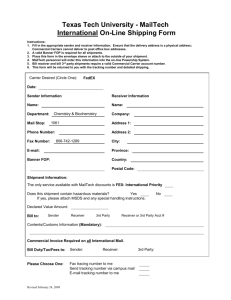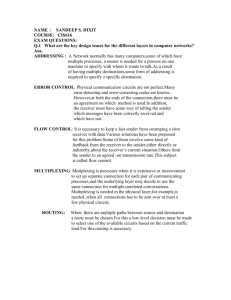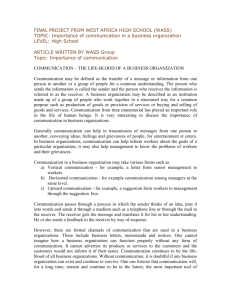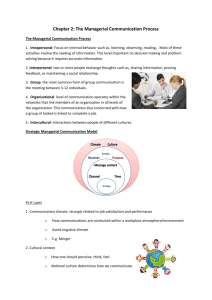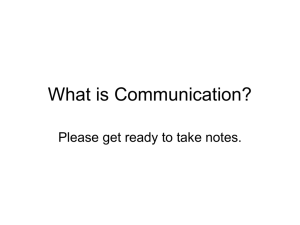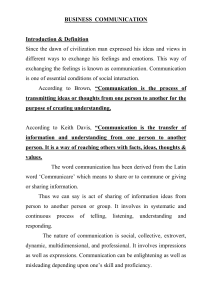CHAPTER 5
advertisement
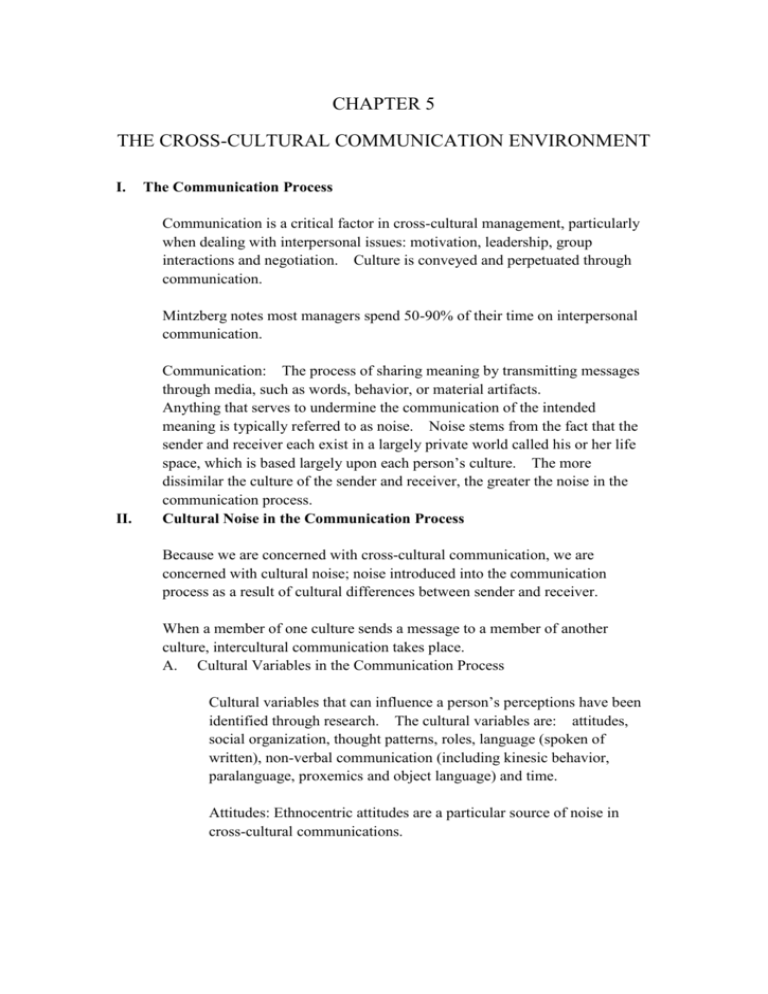
CHAPTER 5 THE CROSS-CULTURAL COMMUNICATION ENVIRONMENT I. The Communication Process Communication is a critical factor in cross-cultural management, particularly when dealing with interpersonal issues: motivation, leadership, group interactions and negotiation. Culture is conveyed and perpetuated through communication. Mintzberg notes most managers spend 50-90% of their time on interpersonal communication. II. Communication: The process of sharing meaning by transmitting messages through media, such as words, behavior, or material artifacts. Anything that serves to undermine the communication of the intended meaning is typically referred to as noise. Noise stems from the fact that the sender and receiver each exist in a largely private world called his or her life space, which is based largely upon each person’s culture. The more dissimilar the culture of the sender and receiver, the greater the noise in the communication process. Cultural Noise in the Communication Process Because we are concerned with cross-cultural communication, we are concerned with cultural noise; noise introduced into the communication process as a result of cultural differences between sender and receiver. When a member of one culture sends a message to a member of another culture, intercultural communication takes place. A. Cultural Variables in the Communication Process Cultural variables that can influence a person’s perceptions have been identified through research. The cultural variables are: attitudes, social organization, thought patterns, roles, language (spoken of written), non-verbal communication (including kinesic behavior, paralanguage, proxemics and object language) and time. Attitudes: Ethnocentric attitudes are a particular source of noise in cross-cultural communications. Stereotyping: When a person assumes that every member of a society or subculture has the same characteristics or traits. This is contrasted with a sociotype. Sociotype: A means of accurately describing members of a group by their traits — which is useful to provide some initial basis for understanding people in a new encounter. Social organization: Our perceptions can be influenced by differences in values, approach or priorities relative to the kind of social organizations to which we belong. Thought patterns: The logical progression of reasoning varies across cultures. Roles: Societies differ considerably as to what they consider the role of a manager. Language can be a barrier to communication when one party has difficulty understanding the other’s language, when there is a lack of understanding of local idioms through a failure to understand body language or from using poor or faulty translations. More than just conveying information, language also conveys cultural and social understandings from one generation to the next. Examples of how language reflects what is important in a society include the 6,000 different Arabic words used to describe camels and their parts and the 50 or more classifications of snow used by the Inuit Eskimos. International managers need a good command of the local language or competent interpreters. The direct translation of specific words does not assure the conveyance of meaning. For example, in Asian culture the word “yes” means only that I have heard you. Politeness, the desire to say only what the listener wishes to hear, adds noise to the communication process. Non-verbal communication (Body language): Behavior that communicates without words. Studies have shown that subtle non-verbal messages account for 65-93% of interpreted communication. The media for non-verbal communication can be categorized into four types: (1) kinesic, (2) proxemics, (3) paralanguage, (4) object language. Paralanguage is the meaning conveyed by how something is said as a result of the rate of speech, the tone and inflection of voice, other noises, laughing or yawning, etc. Object language (or material culture) refers to how we communicate through material artifacts or design. III. Managing Cross-cultural Communication Effectively Steps in the development of effective intercultural communication include the development of cultural sensitivity, careful encoding, selective transmission, careful decoding and appropriate follow-up. A. Developing Cultural Sensitivity: When acting as a sender, a manager must make it a point to know the receiver and to decode the message in a form that will most likely be understood as intended. This requires an awareness on the manager’s part of his or her own cultural baggage. Cultural sensitivity (discussed in Chapter 4) is really just a matter of understanding the other person, the context, and how the person will respond to the context. B. Careful Encoding: In translating his or her intended words into symbols for cross-cultural communication, the sender must use words, pictures or gestures that are appropriate to the receiver’s frame of reference. Senders should avoid idioms and regional sayings (e.g., go fly a kite). Literal translation is only a limited answer to language differences. Language translation is only a part of the encoding process; the message is also expressed non-verbally. C. Selective Transmission The type of medium chosen for the message depends on the nature of the message, its level of importance, the context and expectations of the receiver, the timing involved and the need for personal interaction, among other factors. For the most part, it is best to use face to face interaction for relationship building or for important transactions. Personal interactions give the manager the opportunity to get immediate verbal and visual feedback and to make rapid adjustments in the communication process. D. Careful Decoding of Feedback Checking the decoded message by feedback is essential to ascertain whether the intended message has gotten across. Decoding is the process of translating the received symbols into the interpreted message. The main causes of incongruence are (1) the receiver misinterprets the message, (2) the receiver encodes his of her return message incorrectly, or (3) the sender misinterprets the feedback. E. Follow up actions Managers communicate both through action and inaction. To keep open lines of communication, managers must follow through with action on what has been discussed and then agreed upon — typically a contract, which is probably the most important formal business communication. The management of cross-cultural communication depends largely on a manager’s personal abilities and behavior. The behaviors associated through research with intercultural communication effectiveness are listed below: 1. 2. 3. 4. 5. 6. 7. respect interaction posture orientation to knowledge empathy interaction management tolerance for ambiguity other-oriented role behavior.


